Table of Contents
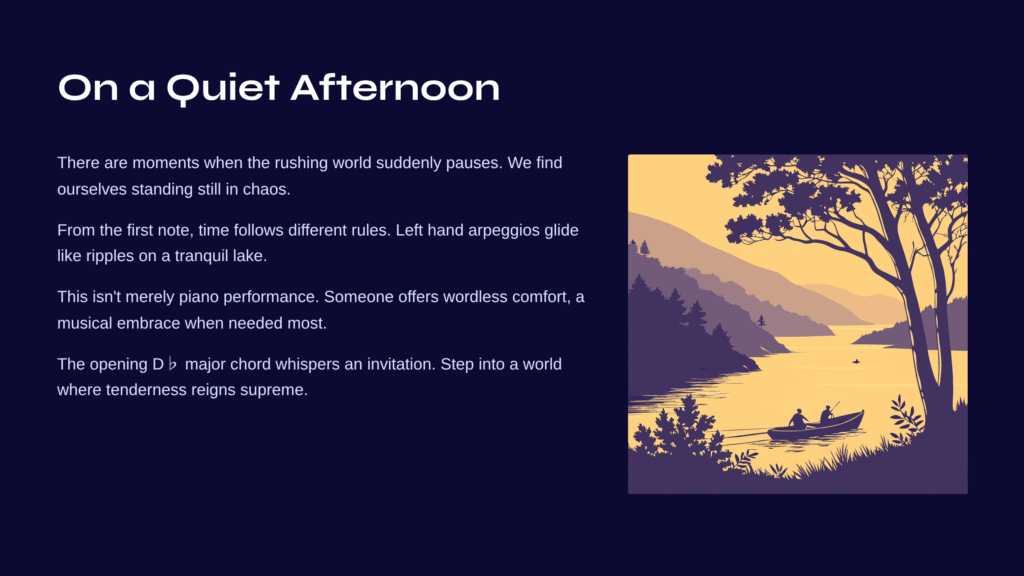
On a Quiet Afternoon, When Melody Finds Its Way to the Heart
There are moments in our lives that defy explanation. Times when the rushing world suddenly pauses, and we find ourselves standing still in the midst of chaos. If there were ever a piece of music to accompany such moments, it would surely be something like Liszt’s Consolation No. 3.
From the very first note, time begins to follow different rules. The left hand’s gentle arpeggios glide across the keys like ripples on a tranquil lake, while the right hand’s melody quietly extends a welcoming gesture. This is not merely a piano performance—this is someone offering you wordless comfort, a musical embrace when you need it most.
The opening D♭ major chord doesn’t announce itself with fanfare; instead, it whispers an invitation to step into a world where tenderness reigns supreme, where vulnerability is not weakness but the very essence of human connection.
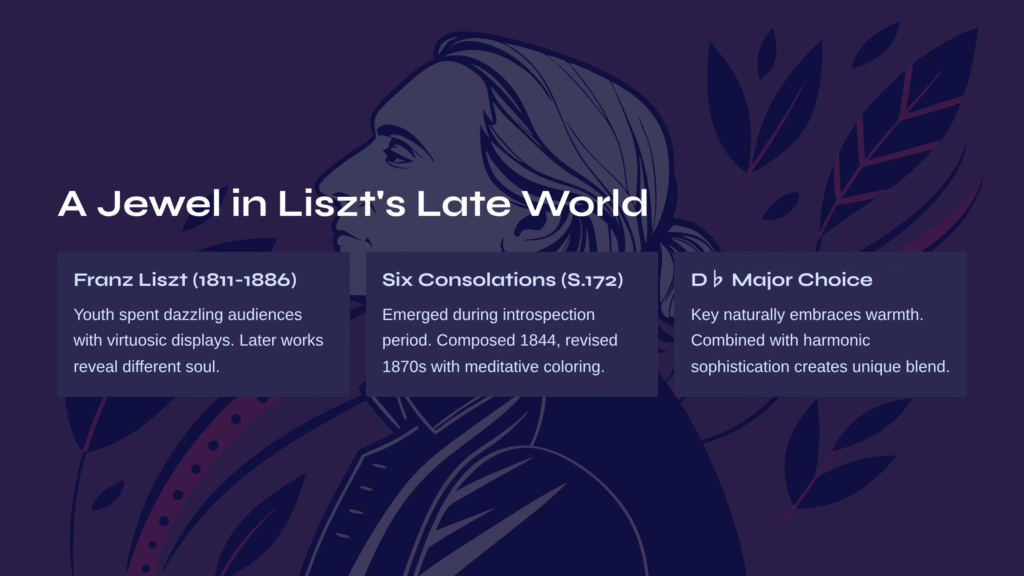
A Jewel in Liszt’s Late Compositional World
Franz Liszt (1811-1886) spent his youth dazzling European audiences with virtuosic displays and passionate performances that bordered on the theatrical. Yet his later works reveal an entirely different soul—one that had learned to find profundity in simplicity, spirituality in restraint.
The six Consolations (S.172) emerged during this period of introspection, initially composed in 1844 but later revised in the 1870s with Liszt’s characteristic meditative coloring and crystalline texture. The third piece in D♭ major has become the most beloved of the set, embodying what we might call the essence of Lisztian consolation.
The choice of D♭ major is itself significant—a key that seems to naturally embrace warmth and gentleness. Combined with Liszt’s late-period harmonic sophistication, it creates a unique blend of chromatic richness and emotional transparency. This is music that seeks not to impress but to heal, not to overwhelm but to understand.
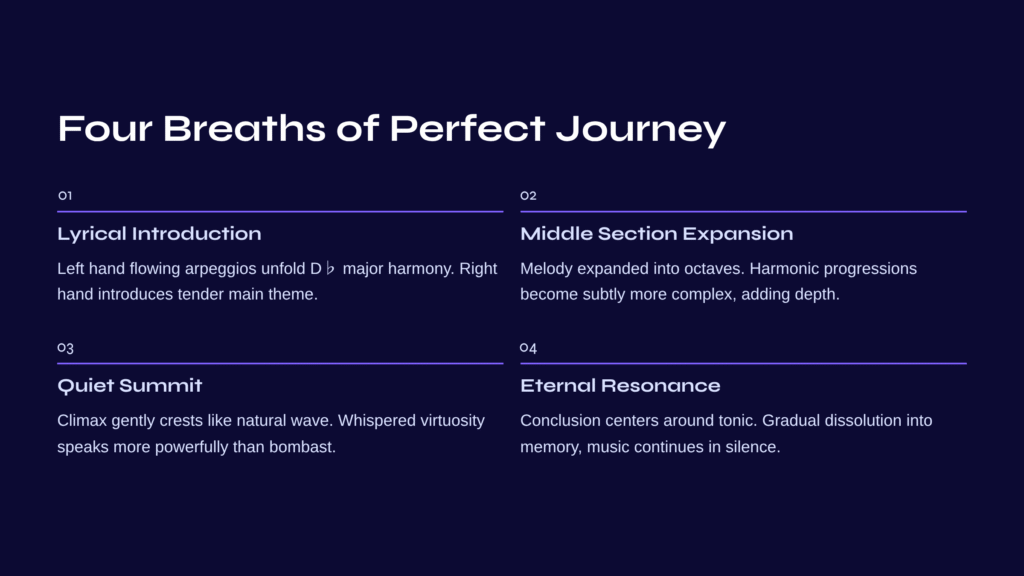
Four Breaths of a Perfect Musical Journey
First Breath: The Magic of Lyrical Introduction
As the piece begins, the left hand takes center stage with a flowing arpeggio pattern that unfolds the D♭ major harmony like petals opening to morning light. These arpeggios appear simple at first glance, yet they contain sophisticated acoustic calculations that create an almost hypnotic effect.
In the fourth measure, the right hand introduces the tender main theme—four measures of melody that somehow contain the weight of all human longing. It’s the musical equivalent of an old friend placing a gentle hand on your shoulder, saying without words, “Everything will be alright.”
This opening theme possesses what the French call simplicité raffinée—refined simplicity. Each note is placed with surgical precision, yet the overall effect feels as natural as breathing.
Second Breath: The Gradual Expansion of the Middle Section
The middle section sees the melody expanded into octaves, creating a fuller sonic landscape while maintaining the piece’s essential restraint. The harmonic progressions become subtly more complex, adding layers of depth without sacrificing the work’s fundamental intimacy.
Here, Liszt demonstrates his mastery of coloristic harmony—progressions that step outside traditional functional harmony to explore more impressionistic territory. These moments hint at the harmonic innovations that would later define early twentieth-century music, yet they never feel anachronistic within the Romantic framework.
Third Breath: The Quiet Summit
The climax of this piece doesn’t explode—it gently crests like a wave reaching its natural peak. Rather than the thunderous fortissimos we might expect from the composer of the Hungarian Rhapsodies, Liszt here employs what we might call “whispered virtuosity”—a mezzo-forte climax that speaks more powerfully than any bombastic gesture could.
This moment represents a profound understanding: true emotional impact comes not from volume but from the authentic expression of feeling. It’s the difference between shouting “I love you” and whispering it at exactly the right moment.
Fourth Breath: Dissolution into Eternal Resonance
The conclusion centers around the tonic, bringing everything full circle, yet this isn’t merely an ending—it’s a gradual dissolution into memory. The final chord doesn’t conclude so much as it evaporates, leaving behind the impression that the music continues to vibrate in the silence that follows.
This technique anticipates the impressionist aesthetic, where endings become beginnings, where closure is replaced by infinite suggestion.
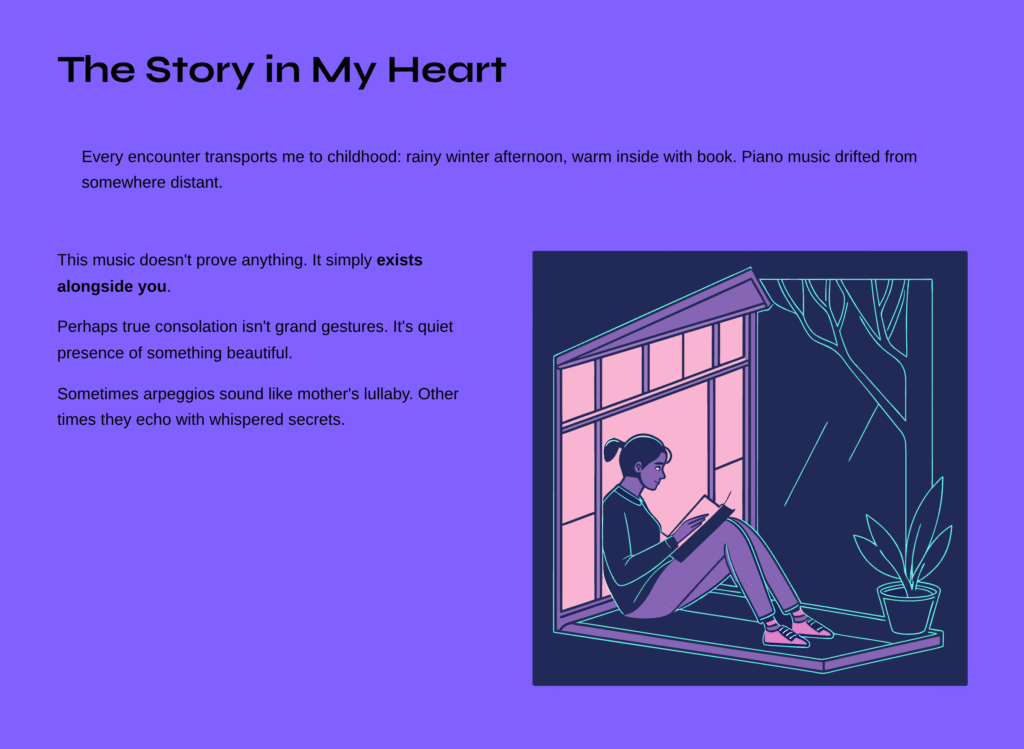
The Story That Resonates in My Heart
Every time I encounter this piece, I’m transported to a specific memory from childhood: a rainy winter afternoon, warm inside with a book, when piano music drifted from somewhere distant and undefined. The peace and security of that moment perfectly aligns with the emotional landscape Liszt creates in Consolation No. 3.
This music doesn’t try to prove anything or teach any lessons. It simply exists alongside you. Perhaps this is the true nature of consolation—not grand gestures or elaborate speeches, but the quiet presence of something beautiful that says, “You are not alone.”
Sometimes the arpeggios sound like a mother’s lullaby; other times they echo with the intimacy of whispered secrets between lovers. Music’s greatest power lies precisely in this resonance with personal memory, its ability to become the soundtrack to our most private moments.
The piece seems to understand that healing doesn’t always require words, that sometimes the most profound comfort comes through pure sound, through the simple acknowledgment that beauty persists even in our darkest hours.
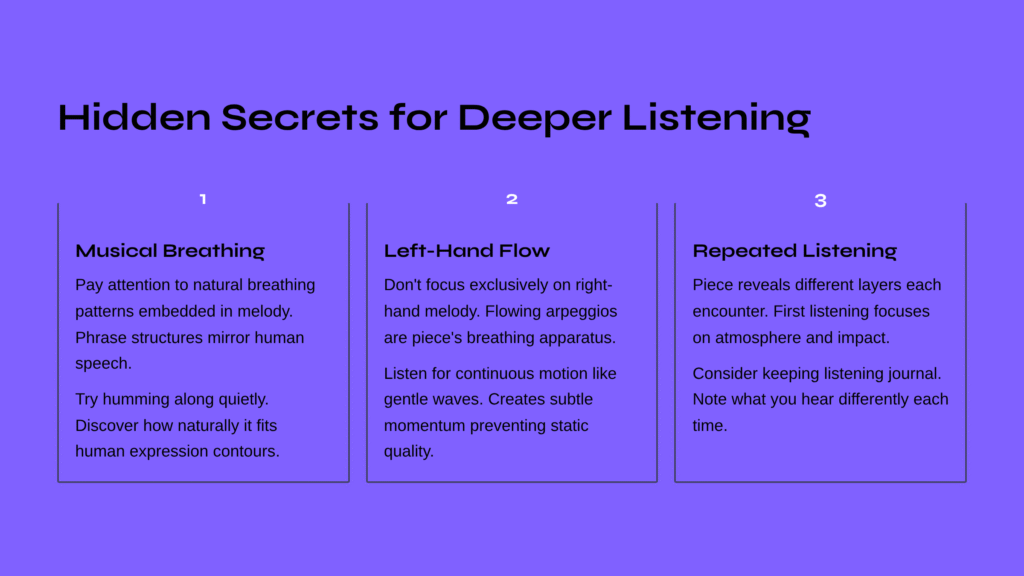
Hidden Secrets for Deeper Listening
First Secret: The Importance of Musical Breathing
When listening to this piece, pay attention to the natural breathing patterns embedded in the melody. Liszt has crafted phrase structures that mirror human speech, complete with natural pauses and emphasis. Following these rhythmic breaths will make the music feel infinitely more intimate and conversational.
Try humming along quietly with the main theme—you’ll discover how naturally it fits the contours of human expression, how effortlessly it matches the rhythm of a gentle heartbeat or the cadence of comforting words.
Second Secret: The Flow of Left-Hand Arpeggios
Don’t focus exclusively on the right-hand melody. The flowing quality of the left-hand accompaniment is equally crucial to the piece’s effect. These arpeggios aren’t mere harmonic support—they’re the piece’s breathing apparatus, the gentle current that carries the melody forward.
Listen for how these patterns create a sense of continuous motion, like gentle waves lapping at a shore. This subtle momentum prevents the piece from becoming static, ensuring that its meditative quality never devolves into mere sentimentality.
Third Secret: The Value of Repeated Listening
This piece reveals different layers with each encounter. The first listening typically focuses on overall atmosphere and emotional impact; subsequent hearings allow you to appreciate the subtle details of harmonic progression and melodic variation. Repeated listening isn’t just recommended—it’s essential for experiencing the work’s full depth.
Consider keeping a listening journal: note what you hear differently each time. You might discover that this piece serves as a kind of musical mirror, reflecting back different aspects of your emotional state depending on when and how you encounter it.

Timeless Comfort and Our Contemporary Lives
There’s profound truth in the saying that music transcends time. Listening to Liszt’s Consolation No. 3 provides perfect evidence: a piece composed in the 19th century continues to offer genuine comfort to 21st-century listeners, bridging the gap between eras with effortless grace.
In our hyperconnected, perpetually busy world, this piece offers something increasingly rare: permission to simply be present. It reminds us that not every moment needs to be productive, that sometimes the most valuable thing we can do is sit quietly and allow beauty to wash over us.
The next time life feels overwhelming, remember this small gem of a piece. Remember that in a complex world, simple beauties endure, and that sometimes the act of listening—really listening—to music can provide all the therapy we need.
Consolation isn’t about grand gestures or dramatic interventions. It’s about the quiet presence of something beautiful that reminds us we’re not alone. Liszt’s Consolation No. 3 embodies this truth perfectly.
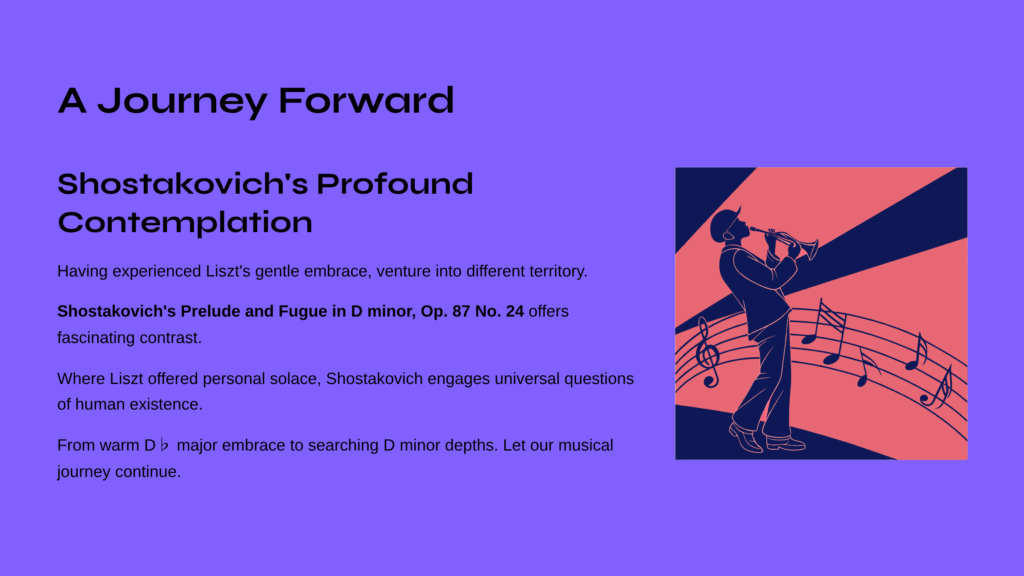
A Journey Forward: Shostakovich’s Profound Contemplation
Having experienced Liszt’s gentle embrace, perhaps it’s time to venture into entirely different territory. Shostakovich’s Prelude and Fugue in D minor, Op. 87 No. 24 offers a fascinating contrast to Liszt’s lyrical consolation—presenting instead deep philosophical reflection and existential questioning.
Born from the turbulent history of 20th-century Russia, this work honors Bach’s contrapuntal tradition while infusing it with thoroughly modern sensibilities. The dialogue between human anguish and hope that unfolds within the strict fugal structure demonstrates classical music’s capacity for profound philosophical discourse.
Where Liszt offered personal solace, Shostakovich engages with universal questions of human existence, inscribing the weight of history into musical notation. From the warm embrace of D♭ major to the searching depths of D minor, from lyrical comfort to intellectual rigor—let our musical journey continue.



